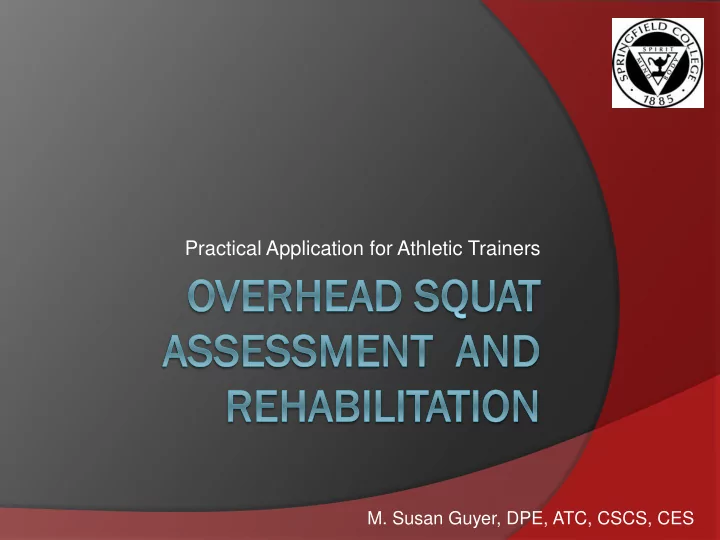

Practical Application for Athletic Trainers M. Susan Guyer, DPE, ATC, CSCS, CES
Which one? NASM - CES FMS SFMA
Assessment The NASM - OHS assessment is the quickest and easiest to perform at the start of the sport season. Information obtained can be used to tailor pre-habilitation programs specifically to the needs of each individual athlete. A word about prevention!
Primary Movements Two Primary Movement Assessment: NASM-CES ○ Overhead Squat ○ Single-leg Squat Dynamic Assessment (other) Single-leg Step Off Functional Movement
Rational - OHS The OHS assesses total body structural alignment dynamic flexibility and neuromuscular control from a bilateral standing posture. Squatting requires optimal motion in the ankles, knees, and hips. Having the arms elevated overhead stresses the musculature surrounding the shoulder complex increases the demand placed upon the core stabilizing muscles.
Rational - OHS To perform the OHS correctly without compensation in structural alignment, one must demonstrate: optimal and bilaterally symmetrical dynamic range of motion at each joint (length-tension relationships) optimal force-couple relationship (proper recruitment strategies).
Practicality Once compensations are found we will be able to tell: Probable overactive muscles Inhibit/Lengthen Flexibility Exercises will be used ○ Self-Myofascial Release (SMR) ○ Static Stretching ○ Neuromuscular Stretching Probable underactive muscles Activate/Integrate Strengthening exercise will be used ○ Positional Isometrics ○ Isolated strengthening ○ Integrated Dynamic Movement
Corrective Exercise Continuum Inhibit Lengthen Activate Integrate
Kinetic Chain Checkpoints Foot/Ankle Knee Lumbo-Pelvic-Hip Compels (LPHC) Shoulder and Cervical Spine (Upper Body)
Overhead Squat Assessment Anterior Lateral Posterior
Set-up Feet straight ahead Shoulder width apart Arms raised above their head as shown
Procedures Perform a series of squats 5 times per view Squat to the depth of an average chair height
Anterior View Kinematic check points Feet Knees Feet Should be straight ahead, 2 nd metatarsal of each foot should be parallel to one another Knees Knees move inward Knees move outward
Anterior View Checkpoint Compensation View Probable Over-active Probable Under-active Muscle Muscle Anterior Feet Turn Out Soleus Med. Gastrocnemius Lat. Gastrocnemius Med. Hamstring Biceps Femoris Gluteus Tensor Fascia Lata (TFL) Medius/Maximus Gracilis Popliteus Knees Move Inward Adductor Complex Med. Hamstring Bicep Femoris (short Med. Gastrocnemius Vastus Medialis (VMO) head) TFL Lat. Gastrocnemius Vastus Lateralis Move Outward Piriformis Adductor Complex Biceps Femoris Med. Hamstring Gluteus Maximus TFL Gluteus Medius Gluteus Minimus
Lateral View Two main Checkpoints LPHC ○ Excessive forward Lean ○ Back Rounds ○ Back Arches Upper body ○ Arms fall forward
Lateral View – Excessive Forward Lean
Lateral View Checkpoint Compensation Probable Overactive Muscle Probable Under-active Muscle View Lateral Upper Body Arms Fall Forward Latissimus Dorsi Mid/Lower Trapezium Pectoralis Major/Minor Rhomboids Coracobrachialis Posterior Deltoid Rotator Cuff LPHC Excessive Forward Soleus Anterior Tibialis Lean Gastrocnemius Gluteus Maximus Hip Flexor complex Erector Spinae Low Back Arches Hip Flexor Complex Gluteus Maximus Intrinsic Core Stabilizers Erector Spinae Latissimus Dorsi Low Back Rounds Hamstrings Gluteus Maximus Adducor magnus Erector Spine Rectus Abdominis Intrinsic Core Stabilizers External Obliques
Posterior View Check Points Feet ○ Flatten ○ Heels Rise LPHC ○ Asymmetrical Weight Shift
Posterior View Checkpoint Compensation View Probable Overactive Probable Under Muscle active Muscle Posterior Feet Flatten Peroneal Complex Posterior Tibialis Toe extensor complex Anterior Tibialis Lat. Gastrocnemius Med. Gastrocnemius Biceps Femoris Gluteus Medius TFL Heel Rise Anterior Tibialis Soleus Gastrocnemius LPHC Asymmetrical Adductor Complex (on Gluteus Medius (on Weight Shift same side of shift) side of shift) TFL Adductor Complex Piriformis (on opposite side of shift) Bicep Femoris Gluteus Medius (on opposite side of shift)
OHS Modifications Heals raised Hands on Hips
Rational - SLS Assesses lower body dynamic flexibility and neuromuscular control as well as balance form a unilateral standing position. Provides a grater challenge to the LPHC as the base of support for the body has been reduced. This forces the core and the priprioception mechanism to work harder. Also assesses functionally applicable movements used in everyday activities.
Single-Leg Squat Assessment Starting Position Feet straight ahead Shoulder width apart Hands on hip Shift weight to one leg Procedures 3 squats with hands on hips Comfortable depth
LPHC – Hip Hike/Hip Drop Pelvis should remain level in the frontal plane LPHC- Hip Hike or drop Knee goes valgus
Single-Leg Step Off Added to OHS and SLS as a dynamic evaluation of biomechanics and function. Most knee injuries occur in the valgus knee position.
Right leg step off
Left leg step off
Functional Movement Scale Designed to evaluate athletic movement of agility, power, speed and functional strength No validity or reliability data as of date
Test Standing long jump Vertical jump
Standig LJ
Standing LJ
VJ
VJ
Most Common Findings Excessive forward lean (weak intrinsic core) Knee Valgus with single leg stance (weak gluteal region/poor balance) Foot Pronation (anterior/posterior tibialis imbalance) Heel Rises (overactive soleus) Correction with heal elevation (LPHC) Erect landing (poor technique)
Excessive Forward Lean (Lateral View) Overactive Underactive Gastrocnemius Anterior Tibialis Soleus Gluteus Maximus Hip Flexor Complex Erector Spinae Abdominal Complex Intrinsic Core Stabilizers ○ Rectus abdominis and External Oblique
Sample Corrective Exercise Program for Excessive Forward Lean Phase Modality Muscles(s) Acute Variables Inhibit SMR Gastrocnemius/soleus Hold on tender Hip flexor Complex area of 30 (TFL/rectus femoris) seconds Lengthen Static Stretching Gastrocnemius/soleus 30-sec hold or 7- or NMS Hip flexor Complex 10 sec. isometric contract, 30 sec. hold Activate Positional Gluteus Maximus 4 reps or Isometrics and/or Core stabilizers increasing Isolated intensity 25, 50, Strengthening 75, 100% OR 10-15 reps with 2 sec. isometric hold and 4 second eccentric Integrate Integrated Ball Wall Squat 10-15 reps Dynamic under control Movement
Knee Valgus Found on Anterior View
Foot Pronation Found on Posterior View
Heel Rises Found on Posterior View
Conclusion Movement assessments are the cornerstone of an integrated assessment process Used to observe the length-tension relationship, force-couple relationships, and joint motions of the entire kinetic chain. This process is only part of the assessment we perform on the athletic prior to competing.
References NASM – CES Movement Assessment NCAA – ISS data
Recommend
More recommend